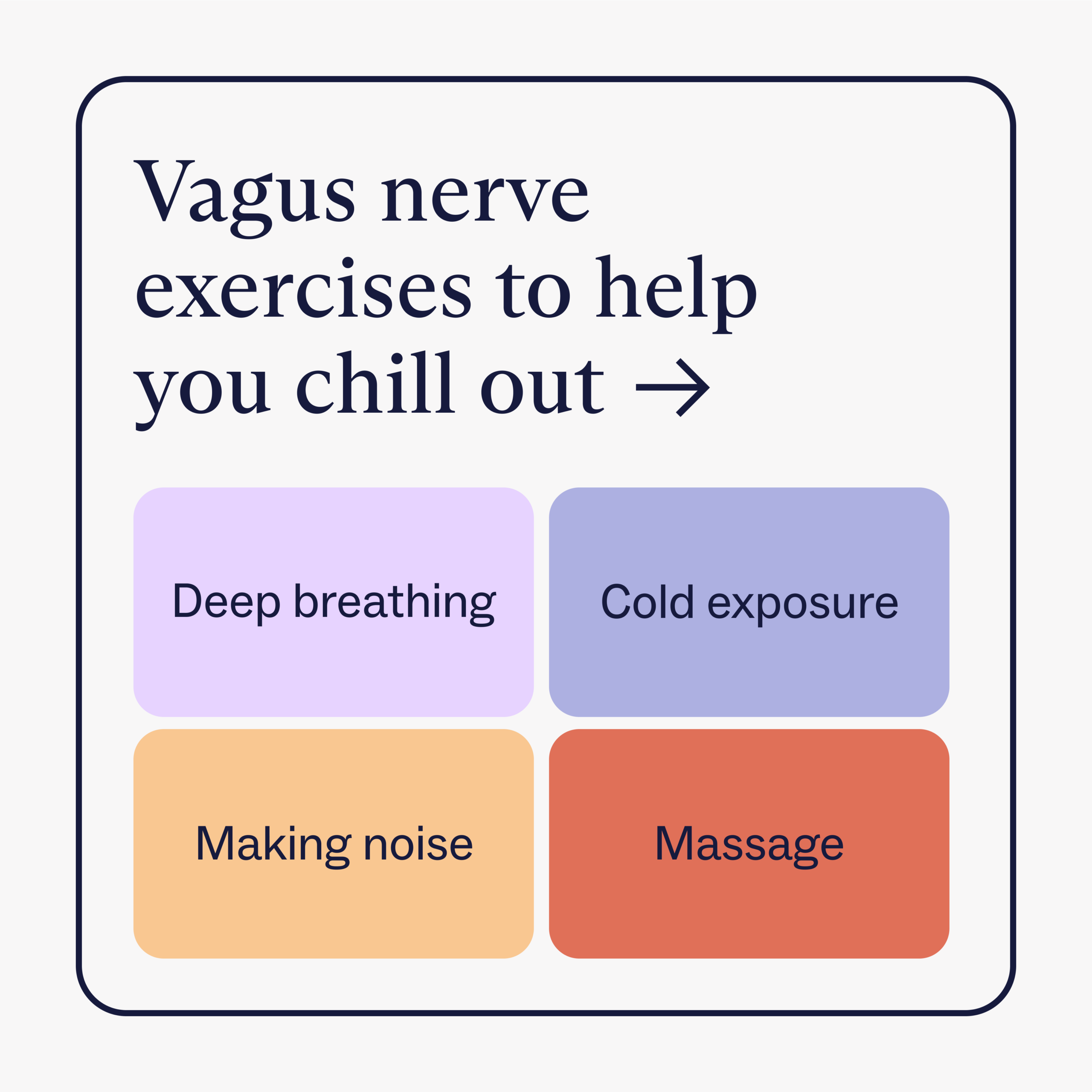
Table of Contents
5 Vagus Nerve Exercises to Help You Chill Out

Written By: Ashley Laderer

Clinically Reviewed By: Dr. Don Gasparini
January 5, 2024
5 min.
Dive into the world of the parasympathetic nervous system and learn about vagus nerve exercises that can help you find your calm.
Learn more about our Clinical Review Process
Table of Contents
The mind and body are inextricably linked, which is why mental health conditions can manifest physically. On the flip side, the mind-body connection can also be utilized to improve well-being. One body technique for improving well-being is the vagus nerve—the longest cranial nerve you have, which plays a big role in regulating your parasympathetic nervous system (the “rest and digest” system linked with relaxation).
“Stimulating the vagus nerve helps to reset after a stress response and restore the body to a steady state,” says Tracye Freeman Valentine, LPC-MHSP, a Clinical Supervisor at Charlie Health. In short, vagus nerve stimulation can help you feel more relaxed if you’re agitated or anxious.
Engaging in vagus nerve stimulation can be especially helpful if you’re in a constant state of “fight-or-flight,” meaning your sympathetic nervous system is activated. Vagus nerve exercises can also help combat the “freeze” state, which may be linked to dorsal vagal shutdown. Below, we delve into some easy vagus nerve exercises you can do to improve vagal tone, activate the parasympathetic nervous system, and, ultimately, help you feel more relaxed.
5 vagus nerve exercises to stimulate the vagus nerve
There are many free, easy ways to stimulate the vagus nerve. Below are five therapist-approved vagus nerve exercises you can do (almost) anywhere. However, it’s worth noting that doing a vagus nerve activity is not a replacement for seeking professional mental health support. If you find yourself overwhelmed with anxiety, consider reaching out for help.
1. Deep breathing
Your breath is a super powerful tool if you know how to use it. Harnessing your breath and doing a breathing exercise is one of the easiest ways to stimulate the vagus nerve, slow down your racing heart, and lower blood pressure. “Deep and slow breathing activates the vagus nerves and leads to a reduction in anxiety and stress responses,” Freeman Valentine says. This can calm the parasympathetic nervous system and help move you out of flight, flight, or freeze into rest and digest.

Struggling with your mental health?
Charlie Health can help. Personalized therapy, multiple times per week.
The best kind of breathing for vagus nerve stimulation is diaphragmatic breathing, where you breathe deep into your belly rather than taking shallow chest breaths. You can make sure you’re activating your diaphragm by laying down with a hand on your belly and making sure it expands when you inhale and contracts when you exhale.
One key thing to remember here is that you should aim to keep your exhales longer than your inhales. This helps activate the vagus nerve and signals the parasympathetic nervous system to enter into rest and digest territory. It can take some practice to do this but try to exhale for double the length of your inhalation. For example, inhale through your nose for the count of two and exhale through your mouth for the count of four. Work your way up to breathing in for four and out for eight. Feel your stress melt away with each long, controlled exhale.
2. Making certain sounds
“Making sounds of vibrations such as humming, singing, or gargling have been shown to stimulate the vagus nerve and activate muscles resulting in an increase in heart rate variability and vagal tone,” Freeman Valentine says.
Put most simply, heart rate variability measures the differences in the duration between your heartbeats. Typically, a higher heart rate variability is linked to better vagal tone. Measuring your heart rate variability is one of the best indicators of your vagal nerve tone and how well your vagus nerve works. So, when you hum, sing, or gargle, these vibrations activate muscles in your throat that are linked to the vagus nerve and, in turn, result in vagus nerve activation.

Join the Charlie Health Library
Get mental health updates, research, insights, and resources directly to your inbox.
You can unsubscribe anytime.
3. Cold exposure
When your body is exposed to cold water, it triggers an inborn physiological response known as the mammalian diving reflex or response. The response activates your vagus nerve, slows down your heart rate, and helps you calm down. While engaging in cold exposure may not be the most comfortable, research shows it is an effective way to improve heart rate variability and vagal tone.
Ways to practice cold exposure for vagus nerve stimulation include:
- Taking a cold shower
- Doing a cold plunge
- Submerging your face in a bowl of ice water
- Holding an ice pack on your neck
4. Physical exercise
As if you needed even more proof that exercising is good for you, research has found that physical activity improves vagal tone. Both interval training and endurance training are great for activating the vagus nerve. “Exercise stimulates the vagus nerve with hormonal responses, which lead to benefits for the brain and mental health,” Freeman Valentine says.
Not to mention, exercise also helps promote mental well-being by releasing feel-good chemicals in your brain like endorphins, serotonin, and dopamine, all of which can reduce stress and boost mood. Pair that with vagus nerve stimulation, and you’ve got a winning combo.

5. Massage
It’s no secret that massages feel amazing, and part of the reason they might be so relaxing is that massages can result in vagus nerve stimulation. As a massage melts away physical tension, it may also improve vagal tone. For example, research has shown that massaging the head and neck area can stimulate vagal sensory neurons and activate the parasympathetic nervous system’s rest and digest mode.
Another study found that reflexology massage of the feet may also help improve vagal tone and lead to further relaxation, even though the feet aren’t near the vagus nerve. Either way, you’re sure to relieve physical tension and mental stress with a massage.

How Charlie Health can help
If you or a loved one are struggling with chronic stress and anxiety, you may need more help than just vagal nerve stimulation. While vagal stimulation can certainly be a helpful tool for your mental health if you are continuously struggling, you may benefit from therapy — and Charlie Health is here to help. Start healing with our virtual Intensive Outpatient Program, which combines group sessions with individual and family therapy for people and families dealing with various serious mental health struggles, including anxiety disorders, mood disorders, and trauma. You will also be matched with a personalized group and get the chance to connect with peers who face similar struggles. Our expert clinicians incorporate evidence-based therapies to help you feel your very best, including mind-body practices like vagal nerve stimulation.
References
https://my.clevelandclinic.org/health/body/23273-autonomic-nervous-system
https://my.clevelandclinic.org/health/body/22279-vagus-nerve
https://cptsdfoundation.org/2020/03/09/shame-blame-and-polyvagal-theory/
https://health.clevelandclinic.org/what-does-the-vagus-nerve-do
https://health.clevelandclinic.org/vagus-nerve-stimulation
https://www.ncbi.nlm.nih.gov/pmc/articles/PMC10182780/
https://www.mindful.org/a-12-minute-breathing-practice-to-activate-your-vagus-nerve/




